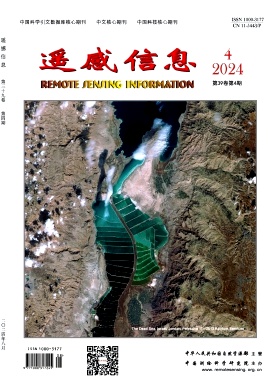偏振SAR合成图像的纹理和散斑统计
引用次数: 43
摘要
作者对偏振SAR合成图像的纹理和散斑统计进行了研究,并在IGARSS'95研讨会上作了初步报告。总结了最近合并的一些结果。本文首先介绍了一种从实验SAR数据进行测量的形式化方法,并以图形的形式简明地表示了图像的统计特性对偏振态的依赖关系。他们特别关注了一点统计量和二阶归一化矩对极化态的依赖。这是经典偏振特征的扩展,在二阶矩的情况下称为偏振纹理特征。将这种形式应用于NASA JPL AIRSAR极化雷达在Les Landes森林上获得的数据集,揭示了纹理特征中一些独特而有趣的趋势。对这一现象的理论解释从考虑将合成操作看作随机变量的线性变换对雷达信号概率分布函数的影响开始。定义了支撑第二矩随极化变化的第一机制;当从相关的单次观测数据在空间域中导出多次观测极化数据时,这种影响就会出现,并且完全是由于统计量的衰落。假设第二种机制可以解释观测到的纹理特征,这是由于底层雷达反射率的极化多样性。这种散射体对极化波响应的不对称性可以用所谓的偏振混合方法来最好地模拟,即为每个分辨率单元组合不同的偏振散射机制。采用蒙特卡罗模拟方法,从假设简单的物理情况出发,重建观测到的特征,这可以在自然目标的散射过程中实现。给出了一个关于确定性点目标和植被杂波混合的例子。从应用的角度来看,一个有趣的结果是,当只有极化多样性而不是辐射多样性起作用时,极化纹理特征被发现是对杂波弱目标的鉴别器。本文章由计算机程序翻译,如有差异,请以英文原文为准。
Texture and speckle statistics in polarimetric SAR synthesized images
A study on the texture and speckle statistics in polarimetric SAR synthesized images was carried out by the authors and presented in preliminary form at the IGARSS'95 Symposium. Some results, which have been recently consolidated, are summarized. The authors introduce at first a formalism to measure from experimental SAR data and represent graphically and in concise form the dependency of the statistical properties of the image on the polarization state. In particular they focus their attention on the one point statistics and on the second order normalized moment dependency on the polarization state. This is an extension of the classical polarimetric signature, and in the case of the second order moment is called the polarimetric texture signature. Application of this formalism to a data set acquired by the NASA JPL AIRSAR polarimetric radar over the Les Landes forest reveals some distinct and interesting trends in the texture signatures. Theoretical explanation of the phenomenon starts from the consideration of the influence of the synthesis operation, seen as a linear transformation of random variables, on the probability distribution function of the radar signal. A first mechanism that underpins the second moment variation with polarization is defined; this effect arises when multi-look polarimetric data are derived in the space domain from correlated single look data, and is entirely due to the fading statistics. A second mechanism is postulated to account for the observed texture signatures, which is due to the polarimetric diversity of the underlying radar reflectivity. This asymmetry in the response of the scatterer to the polarized wave can be best modelled using a so called polarimetric mixture approach, whereby polarimetrically different scattering mechanisms are combined for each resolution cell. A Monte Carlo simulation approach is used to reconstruct the observed signatures, starting from the assumption of simple physical situations, which can be realizable in scattering processes from natural targets. An example is presented, related to a mixture of deterministic point targets and a vegetation clutter. An interesting consequence from the application point of view is that the polarimetric texture signature is found to be a discriminator of weak targets against a clutter, when only polarimetric diversity and not radiometric diversity plays a role.
求助全文
通过发布文献求助,成功后即可免费获取论文全文。
去求助
来源期刊
自引率
0.00%
发文量
3984
期刊介绍:
Remote Sensing Information is a bimonthly academic journal supervised by the Ministry of Natural Resources of the People's Republic of China and sponsored by China Academy of Surveying and Mapping Science. Since its inception in 1986, it has been one of the authoritative journals in the field of remote sensing in China.In 2014, it was recognised as one of the first batch of national academic journals, and was awarded the honours of Core Journals of China Science Citation Database, Chinese Core Journals, and Core Journals of Science and Technology of China. The journal won the Excellence Award (First Prize) of the National Excellent Surveying, Mapping and Geographic Information Journal Award in 2011 and 2017 respectively.
Remote Sensing Information is dedicated to reporting the cutting-edge theoretical and applied results of remote sensing science and technology, promoting academic exchanges at home and abroad, and promoting the application of remote sensing science and technology and industrial development. The journal adheres to the principles of openness, fairness and professionalism, abides by the anonymous review system of peer experts, and has good social credibility. The main columns include Review, Theoretical Research, Innovative Applications, Special Reports, International News, Famous Experts' Forum, Geographic National Condition Monitoring, etc., covering various fields such as surveying and mapping, forestry, agriculture, geology, meteorology, ocean, environment, national defence and so on.
Remote Sensing Information aims to provide a high-level academic exchange platform for experts and scholars in the field of remote sensing at home and abroad, to enhance academic influence, and to play a role in promoting and supporting the protection of natural resources, green technology innovation, and the construction of ecological civilisation.

 求助内容:
求助内容: 应助结果提醒方式:
应助结果提醒方式:


